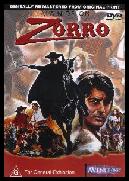
ZORRO
Italy, 1975, 124 minutes, Colour.
Alain Delon, Ottavia Piccolo, Mustache, Giacomo Rossi-Stuart?, Adriana Asti, Stanley Baker.
Directed by Duccio Tessari.
Zorro is yet another incarnation of the famous masked figure. Already in silent days there had been a film of Zorro with Douglas Fairbanks. Tyrone Power brought him to life in Rouben Mamoulian’s 1941 The Mask of Zorro. Guy Madison was a popular more Disney-like Zorro in the 1950s and there were several television series. This French- Italian version was directed by Duccio Tessari, writer and director of many films from the 1960s to the 1990s, a number of them spaghetti westerns, as well as the writer of the original Italian film, Kiss Kiss, Bang Bang.
Alain Delon was a dashing figure in French films of the 60s and 70s and perfectly embodies the matinee idol presence of Zorro. The film is rounded out with an Italian cast as well as some English actors including Stanley Baker.
The legend was poked fun at with George Hamilton in Zorro the Gay Blade. However, Zorro returned to his Hispanic origins and his flair with The Mark of Zorro in 1997 starring Antonio Banderos with Anthony Hopkins as an ageing Zorro. Antonio Banderos, with Catherine Zeta- Jones, reappeared in 2005 in The Legend of Zorro. The legend lives on.
1. How enjoyable an adventure?
2. The popularity of Zorro in literature and film tradition? The film's reliance on Zorro being well known for his story and as a hero?
3. What adventure conventions were pre-supposed and used in this film? How well were they used, the hero, the oppressed village, the secret hero, the villain, soldiers and fighting, romance, the final sword fight and conclusion?
4. The value of the colour and the sets, the costume atmosphere? The photography, the choreography of the fights, the song and the musical accompaniment?
5. Comment on the meaning of the legend of Zorro as explained by the boy. Zorro as the Saviour figure? Don Miguel pretending to be weak? In reality a Zorro figure? The portrayal of legend in a greater way than reality?
6. Comment on the situation In Nuevo Aragons the need for some kind of intervention, poverty and oppression, the aristocracy , the atmosphere of resolution, the cruelty of the soldiers, the role of the monks, the exile of Hortensia's family? Audience response to this kind of social atmosphere?
7. How enjoyable was the pretence of Don Miguel? His tactics against Huerta? The split-second timing of his double identity? Hortensia falling in love with Zorro? The servant helping Zorro? Comment on particular examples where this was most effective.
8. The interventions of Zorro and his saving of the people? The soldiers and Huerta's cruelty? Which particular adventures were most impressive, why?
9. How evil a villain was Huerta? His dominance of the colony? His personal arrogance? His despising of the Governor? His wanting to marry Hortensia? His suspicions about Zorro? His relentless pursuit of Zorro? His skill in battles? The importance of the final duel? His discovery of the truth? Audiences applauding the defeat of the villain?
10. How attractive a heroine was Hortensia? Her social background? Her love for Zorro? The happy ending?
11. The minor characters such as the Friar and his contribution to the film's themes and plot? The young boy? The people who supported Zorro? The servant?
12. The portrayal of the soldiers, especially the fat soldier?
13. Why did swashbuckling costume dramas like this so popular? To whom do they appeal? Why?
14. The spirit of this kind of adventure as embodying fairytale elements for audiences? The Prince Charming, the Princess, the saving of the poor etc.?